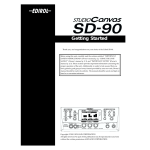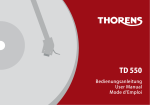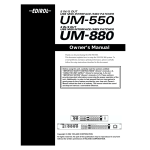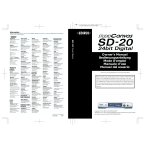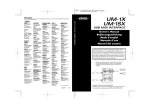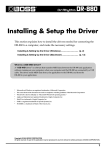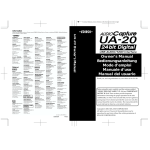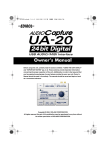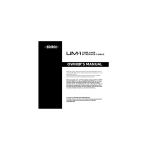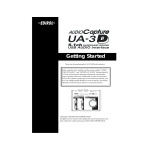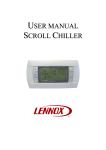Download SD-80_QS
Transcript
Getting Started Thank you, and congratulations on your choice of the STUDIO Canvas SD-80. Before using this unit, carefully read the sections entitled: “IMPORTANT SAFETY INSTRUCTIONS” (Owner’s manual p. 2), “USING THE UNIT SAFELY” (Owner’s manual pp. 3--4), and “IMPORTANT NOTES” (Owner’s manual p. 5). These sections provide important information concerning the proper operation of the unit. Additionally, in order to feel assured that you have gained a good grasp of every feature provided by your new unit, Getting started and Owner’s manual should be read in its entirety. The manual should be saved and kept on hand as a convenient reference. Copyright © 2002 ROLAND CORPORATION All rights reserved. No part of this publication may be reproduced in any form without the written permission of ROLAND CORPORATION. For 230 V (English) This box contains continental and British power cables. Please select the correct type for your country. Für 230 V (Deutsch) Diese Packung beinhaltet europäische und britische Netzkabel. Bitte suchen Sie sich die richtige Variante für Ihr Land aus. Pour 230 V (Français) Cette boite contient des alimentations anglaises ou continentales. Merci de choisir l'alimentation appropriée de votre pays. Per 230 V (Italiano) La confezione contiene alimentatori con spina europea e Inglese. Scegliete quella adatta alla Vostra nazione. Para 230 V (Español) Esta caja contiene cables de corriente continentales y británicos. Por favor seleccione el tipo correcto para su país. Application of AC230 V Power Cord for UK or 2 except for UK Contents Contents ................................................................................... 3 Contents of the Package ......................................................... 4 Connections with audio equipment ....................................... 6 Installing & Setting Up the Driver (Windows)........................ 7 Driver Installation ................................................................................................................ 7 Settings ................................................................................................................................ 19 Check whether there is sound.......................................................................................... 22 Installing & Setting Up the Driver (Macintosh).................... 23 Connecting your Macintosh ............................................................................................. 23 Installing the SD-80 driver (OMS) ................................................................................... 24 Installing the SD-80 driver (FreeMIDI)........................................................................... 28 Troubleshooting..................................................................... 30 Problems related to the USB driver................................................................................. 30 Problems when using the SD-80 ...................................................................................... 34 Deleting the driver............................................................................................................. 37 204 * Microsoft and Windows are registered trademarks of Microsoft Corporation. 206e * Screen shots in this documents are reprinted with permission from Microsoft Corporation. ADD * Windows® XP is known officially as: “Microsoft® Windows® XP operating system.” 206f * Windows® 2000 is known officially as: “Microsoft® Windows® 2000 operating system.” 206g * Windows® Me is known officially as: “Microsoft® Windows® Millennium Edition operating system.” 206c * Windows® 98 is known officially as: “Microsoft® Windows® 98 operating system.” 207 * Apple and Macintosh are registered trademark of Apple Computer, Inc. 209 * MacOS is a trademark of Apple Computer, Inc. 203 * GS ( ) is a registered trademark of Roland Corporation. ADD * XG ( ) and XGlite ( ) are trademarks of YAMAHA Corporation. 231 * OMS is a registered trademark of Opcode Systems, Inc. 232 * FreeMIDI is a trademark of Mark of the Unicorn, Inc. 220 * All product names mentioned in this document are trademarks or registered trademarks of their respective owners. 3 Contents of the Package The box in which the SD-80 was shipped should contain the following items. After opening the box, first check to make sure that all the items are included. If any items are missing, please contact the store where you purchased the SD-80. ●SD-80 ●AC cable This is the only AC cable you should use with the SD-80. Do not use any AC cable other than the supplied one, since doing so may cause malfunction. ●USB Cable ●CD-ROM This contains drivers used by the SD-80, and demo songs. * Avoid touching or scratching the shiny underside (encoded surface) of the disc. Damaged or dirty CD-ROM discs may not be read properly. Keep your discs clean using a commercially available CD cleaner. DO NOT play a CD-ROM disc on a conventional audio CD player. The resulting sound may be of a level that could cause permanent hearing loss. Damage to speakers or other system components may result. ●Getting Started This is the manual you are holding. Please read this first. This manual explains how to install the drivers and make the settings required in order to use the SD-80. Starting at the beginning, please read the sections that are relevant to your system. ●Owner’s Manual This is the owner’s manual for the SD-80. Read this to gain in-depth information concerning the use of the SD-80, and the numerous functions it offers. 4 Contents of the Package ●Rack-mount adaptor Use this when you want to install the SD-80 in an audio rack. Two rack ears are included. Attaching the rack-mount adaptor English fig.um550 1. Remove three screws (on each side) from the right and left panels of the SD-80. 2. Using the screws you removed in step 1, attach the rack-mount brackets to the SD-80. * You must use the screws that you removed. Do not use any other screws. ●Desk-stand mount Use this when you want to place the SD-80 vertically. (with Cushion sets) Attaching the desk-stand mount fig.cushion 1. Remove three screws from the right panel of the SD-80. 2. Affix the cushion set (stickers) to the locations shown in the diagram at right. Cushion set (stickers) 3. Using the screws you removed in step 1, attach the desk-stand mount to the SD-80. * You must use the screws that you removed. Do not use any other screws. When standing the SD-80 on its side, make sure to position it so the power switch is at the bottom. 5 Connections with audio equipment You will not hear any sound from the SD-80 unless you connect headphones to the Headphones jack, or connect the audio outputs (analog) of the SD-80 to your audio playback equipment as shown below. You will need the following items. • SD-80 • Audio cables • Audio playback equipment such as an amp and speakers, or a stereo system * Before making connections to other equipment, you must turn down the volume of all equipment to avoid malfunctions or speaker damage. * To avoid short circuits or broken connections, grasp the plug when disconnecting a cable. * Some connection cables contain a resistor. Do not use a cable with a built-in resistor to connect with the SD-80. Doing so may make the sound extremely weak, or inaudible. For details on your cable, please contact its manufacturer. 1 2 Lower the volume of your audio playback equipment. Connect the SD-80’s OUTPUT1 jacks to the input jacks of your audio playback equipment. If you are using headphones, connect them to the Headphone jack located on the front panel of the SD-80. fig.8-1e INPUT LINE IN OUTPUT 6 SD-80 The following items are required for connections and installation. Remove them from the SD-80 package, and have them ready. • SD-80 • AC cable • USB cable • CD-ROM In order to use the SD-80, you must first install the USB MIDI driver. The installation procedure will differ depending on your system. Please proceed to one of the following sections, depending on the system you use. • Windows XP users ..................................................... (p. 7) • Windows 2000 users................................................... (p. 13) • Windows Me/98 users .............................................. (p. 17) • Macintosh users .......................................................... (p. 23) Driver Installation What is a driver? A “driver” is software that transfers data between the SD-80 and application software running on your computer, when your computer and the SD-80 are connected by a USB cable. The driver sends data from your application to the SD-80, and from the SD-80 to your application. ■ Windows XP users 1 With the SD-80 disconnected, start up Windows. Disconnect all USB cables except for a USB keyboard and USB mouse (if used). 2 Open the System Properties dialog box. 1. Click the Windows Start menu, and from the menu, select Control Panel. If you are using Windows XP Professional, you must log on using a user name with an administrative account type (e.g., Administrator). For details on user accounts, please consult the system administrator of your computer. 2. In “Pick a category”, click “Performance and Maintenance”. 3. In “or pick a Control Panel icon”, click the System icon. Depending on how your system is set up, the System icon may be displayed directly in the Control Panel (the Classic display). In this case, double-click the System icon. 7 English Installing & Setting Up the Driver (Windows) Installing & Setting Up the Driver (Windows) fig.2-1 3 Open the Driver Signing Options dialog box. Click the Hardware tab, and then click [Driver Signing]. fig.2-2 4 Make sure that “What action do you want Windows to take?” is set to “Ignore”. If it is set to “Ignore”, simply click [OK]. If it is not set to “Ignore”, make a note of the current setting (“Warn” or “Block”). Then change the setting to “Ignore” and click [OK]. 5 If you changed “What action do you want Windows to take?” in step 4, you must restore the previous setting after you have installed the driver. (->If you changed “What action do you want Windows to take?” (p. 12)) Close the System Properties dialog box. Click [OK]. 6 Exit all currently running software (applications). Also close any open windows. If you are using virus checking or similar software, be sure to exit it as well. 7 Prepare the CD-ROM. Insert the CD-ROM into the CD-ROM drive of your computer. 8 Open the “Run...” dialog box. Click the Windows start button. From the menu that appears, select “Run...”. 8 If “Windows can perform the same action each time you insert a disk or connect a device with this kind of file” appears, click [Cancel]. Installing & Setting Up the Driver (Windows) 9 In the dialog box that appears, input the following into the “Open” field, and click [OK]. D:\Driver\USB_XP2K\SETUPINF.EXE * The drive name “D:” may be different for your system. Specify the drive name of your CD-ROM drive. In this manual, the location of folders and files is given in terms of the file path, using \ as the delimiter. For example, USB_XP2K\SETUPINF. EXE indicates the SETUPINF.EXE file found in the USB_XP2K folder. fig.2-4_30 10 The SetupInf dialog box will appear. You are now ready to install the driver. If “Do you want to reinstall the driver after uninstalling the driver that is already installed?” appears, click [Yes]. 11 Use the USB cable to connect the SD-80 to your computer. 1. With the power switch turned OFF, connect the AC cable to the SD-80. 2. Connect the AC cable to an electrical outlet. 3. Use the USB cable to connect the SD-80 to your computer. 12 Set the SD-80’s power switch to the ON position. Near the task bar, your computer will indicate “Found New Hardware”. Please wait. fig.2-6 Once the connections have been completed, turn on power to your various devices in the order specified. By turning on devices in the wrong order, you risk causing malfunction and/or damage to speakers and other devices. 13 The Found New Hardware Wizard will appear. Make sure that the screen indicates “EDIROL SD-80”, select “Install from a list or specific location (Advanced)”, and click [Next]. Always make sure to have the volume level turned down before switching on power. Even with the volume all the way down, you may still hear some sound when the power is switched on, but this is normal, and does not indicate a malfunction. 9 English fig.2-3_30 Installing & Setting Up the Driver (Windows) fig.2-7 14 The screen will indicate “Please choose your search and installation options”. Select “Don’t search. I will choose the driver to install”, and click [Next]. fig.2-8_20 15 Make sure that the “Model” field indicates “EDIROL SD-80”, and click [Next]. Driver installation will begin. If the “What action do you want Windows to take?” setting was not set to “Ignore”, a “Hardware Installation” dialog box will appear. If “What action do you want Windows to take?” is set to “Warn,” 1. Click [Continue Anyway]. 2. Continue the installation. If “What action do you want Windows to take?” is set to “Block” 1. Click [OK]. 2. When the “Found New Hardware Wizard” appears, click [Finish]. 3. Perform the installation as described in the “Troubleshooting” section on Device Manager shows “?”, “!”, or “USB Composite Device” (p. 33). 10 Installing & Setting Up the Driver (Windows) fig.2-9_30 appear. Click [OK]. The Insert Disk dialog may not appear. In that case, proceed to step 17. English 16 The Insert Disk dialog box will fig.2-10_30 17 The Files Needed dialog box will appear. Input the following into the “Copy files from” field, and click [OK]. D:\Driver\USB_XP2K * The drive name “D:” may be different for your system. Specify the drive name of your CD-ROM drive. fig.2-11_20 18 The Found New Hardware Wizard will appear. Make sure that the display indicates “EDIROL SD-80”, and click [Finish]. Wait until “Found New Hardware” appears near the taskbar. 19 When driver installation has been completed, the System Setting Change dialog box will appear. Click [Yes]. Windows will restart automatically. 11 Installing & Setting Up the Driver (Windows) If you changed “What action do you want Windows to take?” If you changed the What action do you want Windows to take? setting, restore the original setting after Windows restarts. 1. If you are using Windows XP Professional, log on to Windows using the user name of an administrative account (e.g., Administrator). 2. Click the Windows start menu, and from the menu, select Control Panel. 3. In “Pick a category”, click “Performance and Maintenance”. 4. In “or pick a Control Panel icon”, click the System icon. The System Properties dialog box will appear. 5. Click the Hardware tab, and then click [Driver Signing]. The Driver Signing Options dialog box will appear. 6. Return the What action do you want Windows to take? setting to the original setting (either “Warn” or “Block”), and click [OK]. 7. Click [OK]. The System properties dialog box will close. Next, you need to make the driver settings. (-> MIDI input and output destinations (p. 19)) 12 Depending on how your system is set up, the System icon may be displayed directly in the Control Panel (the Classic display). In this case, double-click the System icon. Installing & Setting Up the Driver (Windows) ■ Windows 2000 users With the SD-80 disconnected, start up Windows. Disconnect all USB cables except for a USB keyboard and USB mouse (if used). 2 3 Log on to Windows as a user with administrative privileges (such as Administrator). Open the System Properties dialog box. Click the Windows Start button, and from the menu that appears, select Settings | Control Panel. In Control Panel, double-click the System icon. fig.2-12 4 If you have already connected the SD-80 to your computer but the “Add New Hardware Wizard” appears, refer to “You attempted to install using the above procedure, but were not able to” in the Troubleshooting section of the Readme_e file included in the Driver\USB_XP2K folder on the CD-ROM. Open the Driver Signing Options dialog box. Click the Hardware tab, and then click [Driver Signing]. fig.2-13_50 5 Make sure that “File signature verification” is set to “Ignore”. If it is set to “Ignore”, simply click [OK]. If it is not set to “Ignore”, make a note of the current setting (“Warn” or “Block”). Then change the setting to “Ignore” and click [OK]. 6 If you changed the “File signature verification” setting in step 5, restore the original setting after Windows restarts. (->If you changed “File signature verification” (p. 16)) Close the System Properties dialog box. Click [OK]. 13 English 1 Installing & Setting Up the Driver (Windows) 7 Exit all currently running software (applications). Also close any open windows. If you are using virus checking or similar software, be sure to exit it as well. 8 Prepare the CD-ROM. Insert the CD-ROM into the CD-ROM drive of your computer. 9 Open the “Run...” dialog box. Click the Windows Start button. From the menu that appears, select “Run...”. fig.2-14_40 10 In the dialog box that appears, input the following into the “Open” field, and click [OK]. D:\Driver\USB_XP2K\SETUPINF.EXE * The drive name “D:” may be different for your system. Specify the drive name of your CD-ROM drive. In this manual, the location of folders and files is given in terms of the file path, using \ as the delimiter. For example, USB_XP2K\SETUPINF. EXE indicates the SETUPINF.EXE file found in the USB_XP2K folder. If a message of “The driver is already installed” appears, you can connect the SD-80 to your computer and use it. fig.2-15_40 11 The SetupInf dialog box will appear. You are now ready to install the driver. Once the connections have been completed, turn on power to your various devices in the order specified. By turning on devices in the wrong order, you risk causing malfunction and/or damage to speakers and other devices. 12 Use the USB cable to connect the SD-80 to your computer. 1. With the power switch turned OFF, connect the AC cable to the SD-80. 2. Connect the AC cable to an electrical outlet. 3. Use the USB cable to connect the SD-80 to your computer. 14 Always make sure to have the volume level turned down before switching on power. Even with the volume all the way down, you may still hear some sound when the power is switched on, but this is normal, and does not indicate a malfunction. Installing & Setting Up the Driver (Windows) 13 Set the SD-80’s power switch to the ON position. English If the “File signature verification” setting was not set to “Ignore”, a “Digital Signature Not Found” dialog box will appear. fig.2-16_30 If “File signature verification” is set to “Warn,” 1. Click [Yes]. 2. Continue the installation. If “File signature verification” is set to “Block” 1. Click [OK]. 2. When the “Found New Hardware Wizard” appears, click [Finish]. 3. Perform the installation as described in the “Troubleshooting” section on Device Manager shows “?”, “!”, or “USB Composite Device” (p. 33). fig.2-17_30 14 The Insert Disk dialog box will appear. Click [OK]. fig.2-18_30 15 The Files Needed dialog box will appear. Input the following into the “Copy files from” field, and click [OK]. D:\Drivers\USB_XP2K * The drive name “D:” may be different for your system. Specify the drive name of your CD-ROM drive. 15 Installing & Setting Up the Driver (Windows) fig.2-17b_30 16 The “Found New Hardware Wizard” may be displayed. Verify that “EDIROL SD-80” is displayed, and click [Finish]. 17 Restart Windows. The System Settings Change dialog box may appear. Click [Yes]. Windows will restart automatically. If you changed “File signature verification” If you changed the “File signature verification” setting, restore the original setting after Windows restarts. 1. After Windows restarts, log in to Windows as a user with administrative privileges, (such as Administrator). 2. In the Windows desktop, right-click the My Computer icon, and from the menu that appears, select Properties. The System Properties dialog box will appear. 3. Click the Hardware tab, and then click [Driver signature]. The Driver Signing Options dialog box will appear. 4. Return the “File signature verification” setting to the original setting (either “Warn” or “Block”), and click [OK]. 5. Click [OK]. The System properties dialog box will close. Next, you need to make the driver settings. (-> MIDI input and output destinations (p. 19) 16 Installing & Setting Up the Driver (Windows) 1 With the SD-80 disconnected, start up Windows. Disconnect all USB cables except for a USB keyboard and USB mouse (if used). 2 Exit all currently running software (applications). Also close any open windows. If you are using virus checking or similar software, be sure to exit it as well. 3 Prepare the CD-ROM. Insert the CD-ROM into the CD-ROM drive of your computer. 4 If you have already connected the SD-80 to your computer but the “Add New Hardware Wizard” appears, refer to “You attempted to install using the above procedure, but were not able to” in the Troubleshooting section of the Readme_e file included in the Driver\USB_ME98 folder on the CD-ROM. Open the “Run...” dialog box. Click the Windows Start button. From the menu that appears, select “Run...”. fig.2-19a_30 5 In the dialog box that appears, input the following into the “Open” field, and click [OK]. D:\Driver\USB_ME98\SETUPINF.EXE In this manual, the location of folders and files is given in terms of the file path, using \ as the delimiter. For example, USB_ME98\SETUPINF. EXE indicates the SETUPINF.EXE file found in the USB_ME98 folder. * The drive name “D:” may be different for your system. Specify the drive name of your CD-ROM drive. fig.2-19_30 6 The SetupInf dialog box will appear. You are now ready to install the driver. If a message of “The driver is already installed” appears, you can connect the SD-80 to your computer and use it. * Do not click [OK] at this time. 17 English ■ Windows Me/98 users Installing & Setting Up the Driver (Windows) 7 Use the USB cable to connect the SD-80 to your computer. 1. With the power switch turned OFF, connect the AC cable to the SD-80. 2. Connect the AC cable to an electrical outlet. 3. Use the USB cable to connect the SD-80 to your computer. 8 Set the SD-80’s power switch to the ON position. fig.2-20_30 9 If you are using Windows 98, an Insert Disk dialog box will appear. Click [OK]. 10 The New Hardware Found dialog box will appear. Input the following into the “Copy files from” field, and click [OK]. fig.2-21a_40 D:\Driver\USB_ME98 * The drive name “D:” may be different for your system. Specify the drive name of your CD-ROM drive. 11 Once the driver has been installed, New Hardware Found dialog box will close. In the SetupInf dialog box, click [OK]. The SETUPINF dialog box will close. Once the connections have been completed, turn on power to your various devices in the order specified. By turning on devices in the wrong order, you risk causing malfunction and/or damage to speakers and other devices. Always make sure to have the volume level turned down before switching on power. Even with the volume all the way down, you may still hear some sound when the power is switched on, but this is normal, and does not indicate a malfunction. If you are using Windows 98 and the Insert Disk dialog box dose not appear, please read The “Insert Disk” dialog box does not appear (p. 33). Next, you need to make the driver settings. (-> MIDI input and output destinations (p. 19) If you were not able to install the SD-80 driver according to the procedure, or if you are unable to use the SD-80 even after installing the driver, you must delete the driver. For details on how to delete the driver, refer to Deleting the driver (p. 37). After deleting the driver, use the procedure described in “Installing & Setting Up the Driver (Windows)” (p. 7) to re-install the driver. 18 If the New Hardware Found dialog box does not appear, re-install the driver using the same procedure as described in The “Insert Disk” dialog box does not appear (p. 33). Installing & Setting Up the Driver (Windows) Settings ■ MIDI input and output destinations 1 English Windows XP/2000/Me users Open Control Panel. Click the Windows Start button, and from the menu that appears, select Settings | Control Panel. Windows XP Click the Windows start button, and from the menu that appears, select Control Panel. 2 Open the Sounds and Audio Devices Properties dialog box (or in Windows 2000/Me, Sounds and Multimedia Properties). Windows XP In “Pick a category”, click “Sound, Speech, and Audio Devices”. Next, in “or pick a Control Panel icon”, click the sounds and Audio Devices icon. Windows 2000/Me In Control Panel, double-click the Sounds and Multimedia icon to open the “Sounds and Multimedia Properties” dialog box. 3 Depending on how your system is set up, the Sounds and Audio Devices icon may be displayed directly in the Control Panel (the Classic display). In this case, double-click the Sounds and Audio Devices icon. Click the Audio tab. fig.2-28_30 4 For MIDI music playback, click the ▼ located at the right of [Default device] (or in Windows 2000/Me, [Preferred device]), and select the following from the list that appears. 1:EDIROL SD-80 PARTA 5 Additional information about the ports SD-80 MIDI OUT1: Sends/receives data from the SD-80’s MIDI OUT 1 connectors SD-80 MIDI OUT2: Sends/receives data from the SD-80’s MIDI OUT 2 connectors Close the Sounds and Audio Devices Properties dialog box. Click OK to complete the settings. Proceed to the next section. •Windows XP users ....................................................... p. 21 •Windows 2000/Me users ............................................. p. 22 SD-80 PART A: Sends/receives data for SD-80 part group A SD-80 PART B: Sends/receives data for SD-80 part group B 19 Installing & Setting Up the Driver (Windows) Windows 98 users 1 Open Control Panel. Click the Windows Start button, and from the menu that appears, select Settings | Control Panel. 2 Open the Multimedia Properties dialog box. In Control Panel, double-click the Multimedia icon to open the “Multimedia Properties” dialog box. 3 Click the MIDI tab. fig.2-29_30 4 Set “MIDI output”. Select [Single instrument], and choose one of the following from the list that appears. 1:EDIROL SD-80 PARTA 5 Close the Multimedia Properties dialog box. Click OK to complete the settings. Proceed to the next section. -> Check whether there is sound (p. 22) 20 Additional information about the ports SD-80 MIDI OUT1: Sends/receives data from the SD-80’s MIDI OUT 1 connectors SD-80 MIDI OUT2: Sends/receives data from the SD-80’s MIDI OUT 2 connectors SD-80 PART A: Sends/receives data for SD-80 part group A SD-80 PART B: Sends/receives data for SD-80 part group B Installing & Setting Up the Driver (Windows) ■ Enabling background services 1 2 3 4 5 6 Click the Windows start button, and from the menu that appears, select Control Panel. In “Pick a category”, click “Performance and Maintenance”. In “or pick a Control Panel icon”, click the System icon. Click the Advanced tab. Depending on how your system is set up, the System icon may be displayed directly in the Control Panel (the Classic display). In this case, double-click the System icon. At the right of the Performance field, click [Settings]. The Performance Options dialog box will appear. Click the Advanced tab. fig.2-30 7 8 In the Processor Scheduling field, select “Background services”, and click [OK]. In the System Properties dialog box, click [OK]. The System Properties dialog box will close. 21 English In Windows XP, perform these settings to make MIDI processing occur more smoothly. These settings are unavailable in Windows 2000/Me/98. Installing & Setting Up the Driver (Windows) Check whether there is sound Next, play back the sample data to verify that the driver installation and settings were performed correctly. ■ Playing back the sample data (MIDI) Here we will use standard Windows functionality to play back the sample data (MIDI). The sample data is found on the CD-ROM. 1 Prepare the CD-ROM. Insert the CD-ROM into the CD-ROM drive of your computer. 2 From the DemoSong\Additional folder of the CD-ROM, drag 01ORCH(.MID) to your desktop to copy it. Use of the demo song supplied with this product for any purpose other than private, personal enjoyment without the permission of the copyright holder is prohibited by law. Additionally, this data must not be copied, nor used in a secondary copyrighted work without the permission of the copyright holder. fig.listen98-1m_50 3 Right-click the copied file 01ORCH(.MID), and select Properties (Play for Windows XP/2000/Me). What you actually see on your computer screen may be different, depending on your computing environment and the operating system you're using. fig.listen98-2m_30 4 Play back the sample data. Click the Preview tab, and then click the button. Was the sample data played back? If it was played back correctly, this means that the computer and the SD-80 are connected correctly, and that the drivers have been installed correctly. 22 If it did not play back correctly, refer to Troubleshooting (p. 34) to determine the reason. This section contains information on how to solve problems such as no sound, or failure to play back correctly. Installing & Setting Up the Driver (Macintosh) English The following items are required for connections and installation. Remove them from the SD-80 package, and have them ready. • SD-80 • AC cable • USB cable • CD-ROM Connecting your Macintosh 1 2 3 4 Turn off the power of the Macintosh and all peripheral devices connected to the Macintosh. With the power switch turned OFF, connect the AC cable to the SD-80. Connect the AC cable to an electrical outlet. Turn on the peripheral devices connected to the Macintosh, except for the SD-80. Then turn on the power of the Macintosh itself. * Do not turn on the power of the SD-80 at this time. If the power of the SD-80 is turned on, a message like the following will appear when the Macintosh is started up. Perform the steps described below as appropriate for the message that is displayed. If the screen indicates: “Driver required for USB device ‘unknown device’ is not available. Search for driver on the Internet?” -> click [Cancel]. If the screen indicates: “Software required for using device ‘unknown device’ cannot be found. Please refer to the manual included with the device, and install the necessary software.” -> click [OK]. Use either OMS or FreeMIDI as the MIDI driver. • If you are using OMS..................................................(p. 24) • If you are using FreeMIDI .........................................(p. 28) * Either OMS or FreeMIDI must be installed in your Macintosh, as appropriate for the sequencer software you are using. What is a driver? A “driver” is software that transfers data between the SD-80 and application software running on your computer, when your computer and the SD-80 are connected by a USB cable. The driver sends data from your application to the SD-80, and from the SD-80 to your application. 23 Installing & Setting Up the Driver (Macintosh) Installing the SD-80 driver (OMS) Use the following procedure to install the SD-80 driver. The included SD-80 OMS driver is an add-on module for using the SD-80 with OMS. In order for you to use it, OMS must already be installed on the hard disk from which you started up. If you would like to learn more about OMS, refer to OMS_2.3_Mac.pdf (online manual) in the OMS2.3.8E folder within the OMS folder of the CD-ROM. * Disconnect the SD-80 from the Macintosh before you perform the installation. 1 Exit all currently running software (applications). If you are using a virus checker or similar software, be sure to exit this as well. 2 Prepare the CD-ROM. Insert the CD-ROM into the CD-ROM drive. 3 4 Verify the Install Location, and click [Install]. If a message like the following is displayed, click [Continue]. The other currently running applications will exit, and installation will continue. 6 You will need the Adobe Acrobat Reader in order to view OMS_2.3_Mac.pdf. The latest version of Adobe Acrobat Reader can be downloaded from the Adobe website. http:// www.adobe.com (This URL may change without notice.) Double-click the SD-80 OMS Driver-E Installer icon (found in the Driver E-OMS folder of the CD-ROM) to start up the installer. fig.3-2_40 5 OMS can be found in the OMS 2.3.8 E folder within the OMS folder of the CD-ROM. Once the connections have been completed, turn on power to your various devices in the order specified. By turning on devices in the wrong order, you risk causing malfunction and/or damage to speakers and other devices. A dialog box will indicate Installation completed. Click [Restart] to restart your Macintosh. 7 8 Use the USB cable to connect the SD-80 to your computer. Set the SD-80’s power switch to the ON position. Always make sure to have the volume level turned down before switching on power. Even with the volume all the way down, you may still hear some sound when the power is switched on, but this is normal, and does not indicate a malfunction. 24 Installing & Setting Up the Driver (Macintosh) OMS settings fig.3-3 From the CD-ROM, drag the Driver E-OMS-Setting folder to the hard disk of your Macintosh to copy it. English 1 fig.3-4 2 In the Opcode-OMS Application folder where you installed OMS, double-click OMS Setup to start it up. fig.3-5_35 3 If a dialog box like the one shown here appears, click [Turn It Off]. A confirmation dialog box will then appear, so click [OK]. We recommend that you turn off AppleTalk, by selecting Chooser from the Apple menu. fig.3-6_35 4 The Create a New Studio Setup dialog box will appear. Click [Cancel]. If you accidentally clicked [OK], click [Cancel] in the next screen. fig.3-7 5 Choose “Open” from the File menu. From the Setting folder that you copied in step 1, select the SD-80 USB file, and click [Open]. fig.3-8_35 A screen like the one shown here will appear. 25 Installing & Setting Up the Driver (Macintosh) fig.3-9_35 6 From the Edit menu, select OMS MIDI Setup. In the OMS MIDI Setup dialog box that appears, check Run MIDI in background, and click [OK]. fig.3-10 7 From the File menu, choose Make Current. If you are unable to select Make Current, it has already been applied, and you may continue to the next step. Additional information about the ports fig.3-11_50 8 Verify that MIDI transmission and reception can be performed correctly. From the Studio menu, choose Test Studio. SD-80 Port A: Sends/receives data for SD-80 part group A SD-80 Port B: Sends/receives data for SD-80 part group B SD-80 MIDI InOut1: Sends/receives data from the SD-80’s MIDI IN 1/ OUT 1 connectors fig.3-22_50 9 When you move the mouse cursor near the sound generator icon, the cursor will change to a shape. Click on the sound generator icon of each port in the diagram at right. If sound is heard from the SD-80, the settings are correct. 26 SD-80 MIDI InOut2: Sends/receives data from the SD-80’s MIDI IN 2/ OUT 2 connectors Installing & Setting Up the Driver (Macintosh) If the PART level meter in the SD-80’s display is moving but you do not hear sound, check whether the volume of the SD-80 or your speaker system has been lowered. If the PART level meter does not move, check the connections and OMS settings once again. If the SD-80 does not produce sound, refer to No sound (p. 34). English Does the SD-80’s PART level meter move? 10 Exit OMS Setup. From the File menu, choose [Exit]. If the AppleTalk confirmation dialog box appears, click [OK] to close the dialog box. This completes the series of steps needed to connect the SD-80 to the Macintosh, install the MIDI driver, and make the driver settings. 27 Installing & Setting Up the Driver (Macintosh) Installing the SD-80 driver (FreeMIDI) Use the following procedure to install the SD-80 driver. The included SD-80 FreeMIDI driver is an add-on module for using the SD-80 with FreeMIDI. In order to use it, FreeMIDI must be installed on the hard disk from which you started up. * Disconnect the SD-80 from the Macintosh before beginning the installation. 1 Exit all currently running software (applications). If you are using a virus checker or similar software, be sure to exit this as well. 2 3 4 Prepare the CD-ROM. Insert the CD-ROM into the CD-ROM drive. Double-click the SD-80 FM Driver-E Installer icon (found in the Driver E-FreeMIDI folder of the CD-ROM) to start up the installer. Verify the Install Location, and click [Install]. fig.3-2_40 5 If a message like the following is displayed, click [Continue]. The other currently running applications will exit, and installation will continue. 6 7 8 A dialog box will indicate Installation completed. Click [Restart] to restart your Macintosh. Use the USB cable to connect the SD-80 to your computer. Switch ON the SD-80’s Power switch. FreeMIDI settings 1 2 28 Once the connections have been completed, turn on power to your various devices in the order specified. By turning on devices in the wrong order, you risk causing malfunction and/or damage to speakers and other devices. From the CD-ROM, copy the Driver E–FreeMIDI–Setting folder onto the hard disk of your Macintosh. Always make sure to have the volume level turned down before switching on power. Even with the volume all the way down, you may still hear some sound when the power is switched on, but this is normal, and does not indicate a malfunction. Open the FreeMIDI Applications folder from the location into which you installed FreeMIDI, and double-click the FreeMIDI Setup icon to start it up. Installing & Setting Up the Driver (Macintosh) 5 6 7 8 9 When “OMS is installed on this computer...” appears, click [FreeMIDI]. Additional information about the ports The first time the software is started up, a dialog box saying “Welcome to FreeMIDI!” will appear. Click [Continue]. When the FreeMIDI Preferences dialog box appears, click [Cancel]. When the About Quick Setup dialog box appears, click [Cancel]. From the File menu, choose Open. Select SD-80 from the FreeMIDI Setting folder you copied in step 1, and click [Open]. Verify that MIDI transmission and reception occur correctly. From the MIDI menu, choose Check Connections. SD-80 Port A: Sends/receives data for SD-80 part group A SD-80 Port B: Sends/receives data for SD-80 part group B SD-80 MIDI InOut1: Sends/receives data from the SD-80’s MIDI IN 1/ OUT 1 connectors SD-80 MIDI InOut2: Sends/receives data from the SD-80’s MIDI IN 2/ OUT 2 connectors fig.3-13_40 10 The mouse cursor will change to the shape of a note. Click on the icon of each port in the diagram at right. If you hear sound, MIDI messages are being sent from the Macintosh to the SD-80. Does the SD-80’s PART level meter move? If the PART level meter in the SD-80’s display is moving but you do not hear sound, check whether the volume of the SD-80 or your speaker system has been lowered. If the PART level meter does not move, check the connections and OMS settings once again. If the SD-80 does not produce sound, refer to “No sound (p. 34)”. 11 Once again choose the MIDI menu command Check Connections to end the test. 12 From the File menu, choose Quit to exit FreeMIDI Setup. This completes the series of steps needed to connect the SD-80 to the Macintosh, install the MIDI driver, and make the driver settings. Now, MIDI data can be input and output (recorded and played). 29 English 3 4 Troubleshooting If an unexpected problem occurs while using the SD-80, read this chapter first. It contains numerous tips for resolving problems. If you are using Windows or Macintosh for the first time, and as a result find it difficult to follow the procedural explanations, please refer to the manuals that came with your computer or operating system. Troubleshooting is organized according to different operating systems. Refer to the icon(s) at the left of the title to find the items you need. Problems common to Windows and Macintosh Problems occurring only in Windows Problems occurring only in Macintosh Problems related to the USB driver Cannot install the driver correctly 30 • Is the CD-ROM correctly inserted into your CD-ROM drive? Installation is not possible unless the CD-ROM included with the SD-80 is inserted in your CD-ROM drive. Make sure that the CD-ROM is correctly inserted into your CD-ROM drive. • Is the CD-ROM or the lens of the CD-ROM dirty? If the CD-ROM or the lens of the CD-ROM drive is dirty, the installer may not work correctly. Clean the disc and/or lens using a commercially-available CD cleaner or lens cleaner. • Are you installing the software from a networked CD-ROM drive? The software cannot be installed from a networked CD-ROM drive. • Is there sufficient free space on your hard disk? Delete unneeded files to increase the amount of free space. After deleting the unneeded files, empty the recycling bin. • Is the SD-80 connected correctly? Make sure that the USB connector of your computer is connected to the SD-80 by a USB cable. Check this, and if you are using Windows, close the Sound and Multimedia Properties dialog box (Sounds and Audio Devices Properties in Windows XP, and Multimedia Properties in Windows 98), re-open the same dialog box once again, and specify the audio and MIDI input/ output destinations. “MIDI input and output destinations”(p. 19). • Is the power of the SD-80 turned on? Make sure that the SD-80’s POWER switch has been pressed inward. Check this, and if you are using Windows, close the Sound and Multimedia Properties dialog box (Sounds and Audio Devices Properties in Windows XP, and Multimedia Properties in Windows 98), re-open the same dialog box once again, and specify the audio and MIDI input/output destinations. Troubleshooting • English • Using the procedure for “Deleting the driver”(p. 37), delete the USB audio device driver installed in your computer, and then re-install the SD-80 driver as described in “Installing & Setting Up the Driver (Windows)”(p. 7). Also check whether there is any “Other devices” in “Device Manager” or “Unknown device” in “Universal Serial Bus Controllers”. If you find any, delete them. Is OMS or FreeMIDI installed? The SD-80 driver cannot be installed unless OMS or FreeMIDI are installed. Please install OMS or FreeMIDI. (OMS -> p. 25, FreeMIDI -> p. 28) SD-80 is not detected when making OMS or FreeMIDI settings • Is the SD-80 detected? Turn the power of the SD-80 off, then on again. Reconnect the USB cable. If other USB devices are connected, connect only the SD-80. It is possible that the Macintosh did not correctly detect and initialize the SD-80. Leave the SD-80’s USB cable connected, and restart your Macintosh. If it is still not detected, shut down your Macintosh, and then restart it. The SD-80 will not be detected if it is connected to the USB connector on the Macintosh keyboard. Please connect the SD-80 to a USB connector on the Macintosh itself. • Are you using only OMS? OMS will not work properly if FreeMIDI is installed in the same system. Delete FreeMIDI-related files from the Extensions folder. 31 Troubleshooting An “Unknown driver found” dialog box appears, and you are unable to install the driver “Find new hardware wizard” does not execute automatically “Find new hardware wizard” ends before the process is completed • It may take about 15 seconds (or more) after the USB cable is connected for the SD-80 to be detected. • Is the USB cable connected correctly? Make sure that the SD-80 and your computer are correctly connected via a USB cable. • Is USB enabled on your computer? Refer to the operation manual for your computer, and make sure that USB is enabled. • It has been found that in some cases, not all of the Windows 98 files required to support audio via USB are installed when a computer is shipped. Please contact the manufacturer of your computer. • Does your computer meet the USB specifications? If you are using a computer that does not fulfill the electrical requirements of the USB specifications, operation may be unstable. In this case, you may be able to solve the problem by connecting a USB hub. • Does “Unknown device” appear for “Other device” or “Universal serial bus controller”? Use the following procedure to delete “Other device” (Universal Serial Bus Controller) “Unknown device”, and then restart your computer. 1. In the Windows Control Panel, double-click System. The System Properties dialog box will appear. 2. Click the Device Manager tab. For Windows 2000, click the Hardware tab, and then click the [Device Manager] button. 3. Double-click “Other device” or “Universal Serial Bus Controller” to display a list of devices. 4. From the list, select the unknown device and click [Delete]. 5. In the dialog box that asks you to confirm the deletion, click [OK]. 6. Verify that “Other device” or “Unknown device” is not displayed in the list, and click [Close] to close the dialog box. “Found unknown device” appears even though you installed the driver If your computer or USB hub has two or more USB connectors, and you connect the SD-80 to a USB connector to which the SD-80 has never been connected before, the “Unknown device” dialog box may appear even on a computer onto which you have already installed the driver. Refer to “Installing & Setting Up the Driver (Windows)”(p. 7), and install the driver once again. This is not a malfunction. 32 Troubleshooting • Did you log on to Windows as a user with administrative privileges? In order to install/delete/re-install the driver in Windows XP/2000, you must be logged into Windows as a user with administrative privileges, such as Administrator. For details, please contact the system administrator for your computer system. • Did you make “Driver Signing Options”? In order to install/re-install the driver, you must make “Driver Signing Options”. (Windows XP -> p. 8, Windows 2000 -> p. 13) English Can’t install/delete/use the driver in Windows XP/2000 Windows XP/2000 displays a “Hardware Installation” or “Digital Signature Not Found” dialog box • Did you make “Driver Signing Options”? In order to install/re-install the driver, you must make the settings described in “Driver Signing Options”. (Windows XP -> p. 8, Windows 2000 -> p. 13) Device Manager shows “?”, “!”, or “USB Composite Device” The “Insert Disk” dialog box does not appear Use the following procedure to re-install the driver. 1. Turn off the power of your computer, and start up Windows with all USB cables disconnected (except for keyboard and mouse). 2. After Windows restarts, use a USB cable to connect the SD-80 to your computer. 3. Turn on the power of SD-80. 4. Click the Windows [Start] button, and from the menu that appears, choose Settings | Control Panel. 5. Double-click the System icon. The System Properties dialog box will appear. 6. Click the Device Manager tab. In Windows XP, select the System Properties Hardware tab, and click Device Manager. 7. Check whether you can see an indication of “?Composite USB Device, ?USB Device, !USB Device”, or “USB composite device” displayed below “Sound, Video, and Game Controllers, Other Devices”, or “Universal Serial Bus Controller”. If you find any such indication, select it and click [Delete]. 8. A dialog box will ask you to confirm deletion of the device. Verify the contents of the dialog box, and then click [OK]. In the same way, delete all indications of “?Composite USB Device”, “?USB Device”, “USB Device”, and “USB composite device” that you find. 9. If you find EDIROL SD-80 USB Driver with a yellow “!” or a red “?” displayed beside it, delete this in the same way. 10. When you have finished deleting the unwanted devices, click [OK] in the System Properties dialog box. 11. Turn off the power of the SD-80, then delete the driver. “Deleting the driver”(p. 37). 33 Troubleshooting 12. Restart Windows. Then install the driver once again. (->“Installing & Setting Up the Driver (Windows)”(p. 7)) * If the problem still occurs after you have taken the above measures, please refer also to the Readme file for the USB driver. The Readme file is on the CD-ROM. Problems when using the SD-80 Operating system becomes unstable • Operation becomes unstable when the computer is started up with the SD-80 already connected Please start up your computer with the SD-80 disconnected, and then connect the SD-80. On a computer that uses a USB keyboard, starting up the computer with the SD-80 already connected may cause operation to become unstable. In this case, start up the computer with the SD-80 disconnected, and then connect the SD-80. No sound 34 • Have you specified the MIDI data output destination for your operating system? You must specify the SD-80 as the audio data output destination for your computer.For details on how to make this setting, refer to Settings and checking. (Windows,“MIDI input and output destinations”(p. 19)/ Macintosh, “OMS settings”(p. 25), “FreeMIDI settings”(p. 28)) • Are you running multiple applications? If multiple applications are running simultaneously, an error message may appear. If this occurs, click [OK] and exit the other applications. Even if an application window is closed, it is still running if it appears in the taskbar. Be sure to exit unneeded applications displayed in the taskbar. • Was the driver installed correctly? In order for you to play back audio data via the SD-80, the driver must be installed. For installation and settings, refer to ”Installing & Setting Up the Driver” (Windows, p. 7 / Macintosh, p. 23). • Is your audio playback equipment (e.g., stereo system) connected correctly? On its own, the SD-80 is not capable of producing sound that you can hear. Make sure that the USB connector of your computer is connected to the SD-80 by a USB cable. Make sure that the SD-80’s OUTPUT 1 (audio output 1) jacks are connected by audio cables to the input jacks of your audio playback equipment. For details on connections, refer to “Connections with audio equipment”(p. 6). • Is the power of your audio equipment turned on? Make sure that the power is turned on for your audio equipment (e.g., stereo) and the SD-80. • Are the various volume settings of the SD-80 set appropriately? The front panel of the SD-80 has separate knobs that adjust the MIDI volumes. Use the Volume knob located on the front panel of the SD-80 to adjust the volume. • Is your computer in Suspend or Sleep mode? If so, get your computer to resume normal operation, then exit all applications that are using the SD-80. Next, turn the SD-80’s power off, then switch it on again. • Did you reconnect the USB cable or turn the power of the SD-80 off and on? Exit all applications that are using the SD-80, and turn the power of the SD-80 off and then on once again. • Is OMS/FreeMIDI set correctly? As described in “OMS settings”(p. 25) or “FreeMIDI settings”(p. 28), check the OMS or FreeMIDI settings. Also make sure that the device for MIDI IN/OUT is correctly selected in the MIDI settings of your MIDI sequencer software. • Does the PART level meter move in the SD-80 display? If the PART level meter is moving but you do not hear sound, check whether the volume of the SD-80 or your speakers has been lowered. If the PART level meter of the SD-80 is not moving, recheck the connections and “OMS settings”(p. 25)/“FreeMIDI settings”(p. 28). • Is the OMS setup enabled? If a diamond-shaped symbol is not displayed at the left edge of the title area in the OMS setup window, the setup is not enabled. From the OMS File menu, choose “Enable setup”. (“OMS settings”(p. 25)) • Has your computer been set to enter Sleep mode? If your computer enters Sleep mode, exit the software you are using, and then restart your computer. We recommend that you set your computer to not use Sleep mode. English Troubleshooting Can’t play back MIDI • Has the MIDI device you are using been set correctly? In order to record/play MIDI tracks using the SD-80, you must correctly install the SD-80 driver (“Installing & Setting Up the Driver (Windows)”(p. 7)). Also make sure that the input port and output port are set as follows in your software. INPUT port EDIROL SD-80 MIDI IN 1 EDIROL SD-80 MIDI IN 2 OUTPUT port EDIROL SD-80 PART A EDIROL SD-80 PART B 35 Troubleshooting • Has the MIDI device you are using been selected correctly? Select either [SD-80 Port A] or [SD-80 Port B] as the MIDI output device. • Are the track outputs set correctly? MIDI tracks to which no MIDI playback device is assigned will not be heard. If you want to play back a MIDI track, you must make sure that the MIDI device you want to use is displayed in your software as the MIDI output port. For details, refer to the owner’s manual for your software. Can’t record MIDI • 36 Has the MIDI input device you are using been selected correctly? Select either [SD-80 MIDI InOut 1] or [SD-80 MIDI InOut 2] as the MIDI input device. Troubleshooting Deleting the driver English If you were unable to install the driver according to the procedure given, the SD-80 may not be recognized correctly by the computer. In this case, use the following procedure to delete the driver, and then follow the procedure in “Installing & Setting Up the Driver” (Windows, p. 7; Macintosh, p. 23) to install the driver once again. Windows XP/2000 users In order to delete (uninstall) the driver, a user with administrative privileges such as Administrator must be logged onto Windows. For details, contact the system administrator of your computer. 1. With all USB cables disconnected, start Windows. (USB keyboard and USB mouse excepted) 2. Log on to Windows as a user with administrative privileges (such as Administrator). 3. After connecting the SD-80 to your computer via a USB cable, turn on the power of the SD-80. 4. Exit all applications before deleting the driver. 5. Open the Control Panel, and double-click System. 6. Click the Hardware tab, and in the “Device Manager” area, click [Device Manager]. 7. Double-click “Sound, Video, and Game Controllers” to view the list of devices. 8. From the list, click “EDIROL SD-80” to select it. Then right-click, and from the menu that appears, select “Delete”. * If “EDIROL SD-80” does not appear in the list, refer to the “Can’t install/delete/use the driver in Windows XP/2000”(p. 33) in “Troubleshooting”. 9. A dialog box will ask you to confirm that you want to delete the device. Verify the contents of the dialog box, and click [OK]. 10. Close the Device Manager window, and click [OK] in System Properties. 11. Disconnect the USB cable from the SD-80. 12. Restart Windows. 37 Troubleshooting Windows Me/98 users 1. With all USB cables disconnected, start up Windows. (USB keyboard and USB mouse excepted) 2. After connecting the SD-80 to your computer via a USB cable, turn on the power of the SD-80. 3. Exit all applications before deleting the driver. 4. Open the Control Panel, and double-click System. * Depending on the state of your computer, System may not appear in the Control Panel. In this case, click “Show all control panel options”. 5. Click the Device Manager tab. 6. Double-click “Sound, video, and game controllers” to see a list of devices. 7. From the list, click “EDIROL SD-80” to select it, and click [Delete]. 8. A dialog box will appear, asking you to confirm that you want to delete the driver. Verify the contents, and click [OK]. 9. Click [Close] to close System Properties. 10. Disconnect the USB cable from the SD-80. 11. In Control Panel, click Folder Options and then click the Display tab. (In Windows 98, click Start | Settings | Folder Options.1.) 12. In Detailed Settings of the Display tab, remove the check mark for “Don’t display extensions of associated files”, click “Show all files and folders”, and then click [OK]. (In Windows 98, this will be “Show all files”.) 13. Click Start | Find | Files or folders. 14. In “Search location”, select “Local hard drive”. Then in “Name of file or folder”, type “*0023.*” and click [Begin search]. 15. Of the files that are found, delete the five files Rddp0023.dat, Rddv0023.drv, Rdvx0023.vxd, and Rdwm0023.sys. If the list shows Rdif0023.inf or RolandRDIF0023.INF, delete these files as well. * Never delete any file other then the files specified here. 16. Restart Windows. Macintosh users 1. Turn off the power of the SD-80. Also disconnect the USB cable (by which the SD-80 is connected) from your Macintosh. 2. From the system extensions folder, drag “USB SD-80 Driver” into the trash to delete it. 3. Delete SD-80 from the OMS Folder inside the System folder, or drag SD-80 Driver from the FreeMIDI Folder to the trash. 4. Restart the Macintosh. 38 Information EUROPE EDIROL (Europe) Ltd. Studio 3.4 114 Power Road London W4 5PY U. K. TEL: +44 (0)20 8747 5949 FAX:+44 (0)20 8747 5948 http://www.edirol.com/europe Deutschland TEL: 0700 33 47 65 20 France TEL: 0810 000 371 Italia TEL: 02 93778329 When you need repair service, call your nearest EDIROL/Roland Service Center or authorized EDIROL/Roland distributor in your country as shown below. HONG KONG BARBADOS PERU IRELAND CYPRUS Parsons Music Ltd. 8th Floor, Railway Plaza, 39 Chatham Road South, T.S.T, Kowloon, HONG KONG TEL: 2333 1863 A&B Music Supplies LTD 12 Webster Industrial Park Wildey, St.Michael, Barbados TEL: (246)430-1100 Audionet Distribuciones Musicales SAC Juan Fanning 530 Miraflores Lima - Peru TEL: (511) 4461388 Roland Ireland G2 Calmount Park, Calmount Avenue, Dublin 12 Republic of IRELAND TEL: (01) 4294444 Radex Sound Equipment Ltd. 17, Diagorou Street, Nicosia, CYPRUS TEL: (022) 66-9426 INDIA Rivera Digitec (India) Pvt. Ltd. 409, Nirman Kendra Mahalaxmi Flats Compound Off. Dr. Edwin Moses Road, Mumbai-400011, INDIA TEL: (022) 2493 9051 INDONESIA PT Citra IntiRama J1. Cideng Timur No. 15J-150 Jakarta Pusat INDONESIA TEL: (021) 6324170 KOREA NORTH AMERICA CANADA Roland Canada Music Ltd. (Head Office) 5480 Parkwood Way Richmond B. C., V6V 2M4 CANADA TEL: (604) 270 6626 Roland Canada Music Ltd. (Toronto Office) 170 Admiral Boulevard Mississauga On L5T 2N6 CANADA TEL: (905) 362 9707 U. S. A. Roland Corporation U.S. 5100 S. Eastern Avenue Los Angeles, CA 90040-2938, U. S. A. TEL: (323) 890 3700 AFRICA Cosmos Corporation 1461-9, Seocho-Dong, Seocho Ku, Seoul, KOREA TEL: (02) 3486-8855 MALAYSIA/ SINGAPORE Roland Asia Pacific Sdn. Bhd. 45-1, Block C2, Jalan PJU 1/39, Dataran Prima, 47301 Petaling Jaya, Selangor, MALAYSIA TEL: (03) 7805-3263 PHILIPPINES G.A. Yupangco & Co. Inc. 339 Gil J. Puyat Avenue Makati, Metro Manila 1200, PHILIPPINES TEL: (02) 899 9801 TAIWAN ROLAND TAIWAN ENTERPRISE CO., LTD. Room 5, 9fl. No. 112 Chung Shan N.Road Sec.2, Taipei, TAIWAN, R.O.C. TEL: (02) 2561 3339 EGYPT THAILAND Al Fanny Trading Office 9, EBN Hagar A1 Askalany Street, ARD E1 Golf, Heliopolis, Cairo 11341, EGYPT TEL: 20-2-417-1828 Theera Music Co. , Ltd. 330 Soi Verng NakornKasem, New Road, Sumpantawongse, Bangkok 10100, THAILAND TEL: (02) 224-8821 REUNION Maison FO - YAM Marcel 25 Rue Jules Hermann, Chaudron - BP79 97 491 Ste Clotilde Cedex, REUNION ISLAND TEL: (0262) 218-429 SOUTH AFRICA Paul Bothner(PTY)Ltd. Royal Cape Park, Unit 24 Londonderry Road, Ottery 7800 Cape Town, SOUTH AFRICA TEL: (021) 799 4900 ASIA CHINA Roland Shanghai Electronics Co.,Ltd. 5F. No.1500 Pingliang Road Shanghai 200090, CHINA TEL: (021) 5580-0800 Roland Shanghai Electronics Co.,Ltd. (BEIJING OFFICE) 10F. No.18 3 Section Anhuaxili Chaoyang District Beijing 100011 CHINA TEL: (010) 6426-5050 Roland Shanghai Electronics Co.,Ltd. (GUANGZHOU OFFICE) 2/F., No.30 Si You Nan Er Jie Yi Xiang, Wu Yang Xin Cheng, Guangzhou 510600, CHINA TEL: (020) 8736-0428 VIETNAM SAIGON MUSIC DISTRIBUTOR (TAN DINH MUSIC) 138 Tran Quang Khai Street Dist. 1, Ho Chi Minh City VIETNAM TEL: (08) 848-4068 AUSTRALIA/ NEW ZEALAND AUSTRALIA/ NEW ZEALAND Roland Corporation Australia Pty.,Ltd. 38 Campbell Avenue Dee Why West. NSW 2099 AUSTRALIA For Australia Tel: (02) 9982 8266 For New Zealand Tel: (09) 3098 715 CENTRAL/LATIN AMERICA ARGENTINA Instrumentos Musicales S.A. Av.Santa Fe 2055 (1123) Buenos Aires ARGENTINA TEL: (011) 4508-2700 BRAZIL Roland Brasil Ltda. Rua San Jose, 780 Sala B Parque Industrial San Jose Cotia - Sao Paulo - SP, BRAZIL TEL: (011) 4615 5666 CHILE Comercial Fancy II S.A. Rut.: 96.919.420-1 Nataniel Cox #739, 4th Floor Santiago - Centro, CHILE TEL: (02) 688-9540 COLOMBIA Centro Musical Ltda. Cra 43 B No 25 A 41 Bododega 9 Medellin, Colombia TEL: (574)3812529 CURACAO Zeelandia Music Center Inc. Orionweg 30 Curacao, Netherland Antilles TEL:(305)5926866 TRINIDAD AMR Ltd Ground Floor Maritime Plaza Barataria Trinidad W.I. TEL: (868)638 6385 URUGUAY Todo Musica S.A. Francisco Acuna de Figueroa 1771 C.P.: 11.800 Montevideo, URUGUAY TEL: (02) 924-2335 VENEZUELA Instrumentos Musicales Allegro,C.A. Av.las industrias edf.Guitar import #7 zona Industrial de Turumo Caracas, Venezuela TEL: (212) 244-1122 DOMINICAN REPUBLIC Instrumentos Fernando Giraldez Calle Proyecto Central No.3 Ens.La Esperilla Santo Domingo, Dominican Republic TEL:(809) 683 0305 ECUADOR Mas Musika Rumichaca 822 y Zaruma Guayaquil - Ecuador TEL:(593-4)2302364 EUROPE AUSTRIA Roland Elektronische Musikinstrumente HmbH. Austrian Office Eduard-Bodem-Gasse 8, A-6020 Innsbruck, AUSTRIA TEL: (0512) 26 44 260 ITALY Roland Italy S. p. A. Viale delle Industrie 8, 20020 Arese, Milano, ITALY TEL: (02) 937-78300 MOCO INC. No.41 Nike St., Dr.Shariyati Ave., Roberoye Cerahe Mirdamad Tehran, IRAN TEL: (021) 285-4169 NORWAY ISRAEL Roland Scandinavia Avd. Kontor Norge Lilleakerveien 2 Postboks 95 Lilleaker N-0216 Oslo NORWAY TEL: 2273 0074 Halilit P. Greenspoon & Sons Ltd. 8 Retzif Ha’aliya Hashnya St. Tel-Aviv-Yafo ISRAEL TEL: (03) 6823666 POLAND MX MUSIC SP.Z.O.O. UL. Gibraltarska 4. PL-03664 Warszawa POLAND TEL: (022) 679 44 19 MUSIC HOUSE CO. LTD. FREDDY FOR MUSIC P. O. Box 922846 Amman 11192 JORDAN TEL: (06) 5692696 PORTUGAL KUWAIT Roland Iberia, S.L. Portugal Office Cais das Pedras, 8/9-1 Dto 4050-465, Porto, PORTUGAL TEL: 22 608 00 60 EASA HUSAIN AL-YOUSIFI & SONS CO. Abdullah Salem Street, Safat, KUWAIT TEL: 243-6399 ROMANIA LEBANON FBS LINES Piata Libertatii 1, 535500 Gheorgheni, ROMANIA TEL: (266) 364 609 Chahine S.A.L. Gerge Zeidan St., Chahine Bldg., Achrafieh, P.O.Box: 165857 Beirut, LEBANON TEL: (01) 20-1441 RUSSIA MuTek Dorozhnaya ul.3,korp.6 117 545 Moscow, RUSSIA TEL: (095) 981-4967 BELGIUM/FRANCE/ HOLLAND/ LUXEMBOURG SPAIN Roland Central Europe N.V. Houtstraat 3, B-2260, Oevel (Westerlo) BELGIUM TEL: (014) 575811 Roland Iberia, S.L. Paseo García Faria, 33-35 08005 Barcelona SPAIN TEL: 93 493 91 00 HONDURAS CZECH REP. SWEDEN Almacen Pajaro Azul S.A. de C.V. BO.Paz Barahona 3 Ave.11 Calle S.O San Pedro Sula, Honduras TEL: (504) 553-2029 K-AUDIO Kardasovska 626. CZ-198 00 Praha 9, CZECH REP. TEL: (2) 666 10529 Roland Scandinavia A/S SWEDISH SALES OFFICE Danvik Center 28, 2 tr. S-131 30 Nacka SWEDEN TEL: (0)8 702 00 20 MARTINIQUE DENMARK SWITZERLAND Musique & Son Z.I.Les Mangle 97232 Le Lamantin Martinique F.W.I. TEL: 596 596 426860 Roland Scandinavia A/S Nordhavnsvej 7, Postbox 880, DK-2100 Copenhagen DENMARK TEL: 3916 6200 Roland (Switzerland) AG Landstrasse 5, Postfach, CH-4452 Itingen, SWITZERLAND TEL: (061) 927-8383 FINLAND UKRAINE Roland Scandinavia As, Filial Finland Elannontie 5 FIN-01510 Vantaa, FINLAND TEL: (0)9 68 24 020 TIC-TAC Mira Str. 19/108 P.O. Box 180 295400 Munkachevo, UKRAINE TEL: (03131) 414-40 GUATEMALA Casa Instrumental Calzada Roosevelt 34-01,zona 11 Ciudad de Guatemala Guatemala TEL:(502) 599-2888 Gigamusic SARL 10 Rte De La Folie 97200 Fort De France Martinique F.W.I. TEL: 596 596 715222 MEXICO Casa Veerkamp, s.a. de c.v. Av. Toluca No. 323, Col. Olivar de los Padres 01780 Mexico D.F. MEXICO TEL: (55) 5668-6699 NICARAGUA Bansbach Instrumentos Musicales Nicaragua Altamira D'Este Calle Principal de la Farmacia 5ta.Avenida 1 Cuadra al Lago.#503 Managua, Nicaragua TEL: (505)277-2557 GERMANY Roland Elektronische Musikinstrumente HmbH. Oststrasse 96, 22844 Norderstedt, GERMANY TEL: (040) 52 60090 GREECE STOLLAS S.A. Music Sound Light 155, New National Road Patras 26442, GREECE TEL: 2610 435400 HUNGARY Roland East Europe Ltd. Warehouse Area ‘DEPO’ Pf.83 H-2046 Torokbalint, HUNGARY IRAN JORDAN OMAN TALENTZ CENTRE L.L.C. Malatan House No.1 Al Noor Street, Ruwi SULTANATE OF OMAN TEL: 2478 3443 QATAR Badie Studio & Stores P.O. Box 62, Doha, QATAR TEL: 423554 SAUDI ARABIA aDawliah Universal Electronics APL Corniche Road, Aldossary Bldg., 1st Floor, Alkhobar, SAUDI ARABIA P.O.Box 2154, Alkhobar 31952 SAUDI ARABIA TEL: (03) 898 2081 SYRIA Technical Light & Sound Center Rawda, Abdul Qader Jazairi St. Bldg. No. 21, P.O.BOX 13520, Damascus, SYRIA TEL: (011) 223-5384 TURKEY UNITED KINGDOM Roland (U.K.) Ltd. Atlantic Close, Swansea Enterprise Park, SWANSEA SA7 9FJ, UNITED KINGDOM TEL: (01792) 702701 MIDDLE EAST ZUHAL DIS TICARET A.S. Galip Dede Cad. No.37 Beyoglu - Istanbul / TURKEY TEL: (0212) 249 85 10 U.A.E. Zak Electronics & Musical Instruments Co. L.L.C. Zabeel Road, Al Sherooq Bldg., No. 14, Grand Floor, Dubai, U.A.E. TEL: (04) 3360715 BAHRAIN Moon Stores No.16, Bab Al Bahrain Avenue, P.O.Box 247, Manama 304, State of BAHRAIN TEL: 17 211 005 TEL: (23) 511011 As of December 10, 2005 (EDIROL-1)







































